电子科技大学:《物理与化学电源基础 Fundamental of Physical and Chemical Power Sources》课程教学资源(课件讲稿,第一部分)Section II Nuclear energy(Fundamentals of Fusion Enery)
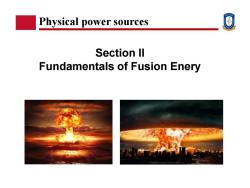
Physical power sources Section II Fundamentals of Fusion Enery
Section II Fundamentals of Fusion Enery Physical power sources

Fusion Enery How is such powerful energy in the sun achieved? How much energy does the sun radiate per second? 3.8×1026J How many kilos does the sun The sun lose per second? Solar central temperature:106 K(core 4×109kg temperature up to 15 million degrees) Very high pressure:300 billion atmospheres ●A lot of particles Considerable time span The reaction cross section is large enough
Fusion Enery How is such powerful energy in the sun achieved? Solar central temperature: 106 K (core temperature up to 15 million degrees) Very high pressure: 300 billion atmospheres A lot of particles Considerable time span The reaction cross section is large enough The sun How much energy does the sun radiate per second? 3.8× 1026 J How many kilos does the sun lose per second? 4×109 kg
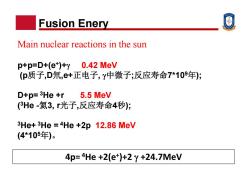
Fusion Enery Main nuclear reactions in the sun p+p=D+(e+)+y 0.42 MeV (p质子,D氘,e+正电子,y中微子;反应寿命7*109年); D+p=3He +r 5.5 MeV (3He氦3,r光子,反应寿命4秒) 3He+3He =4He +2p 12.86 MeV (4*105年)。 4p=4He+2(et)+2y+24.7MeV
Fusion Enery p+p=D+(e+ )+ 0.42 MeV (p质子,D氘,e+正电子, 中微子;反应寿命7*109年); D+p= 3He +r 5.5 MeV ( 3He -氦3, r光子,反应寿命4秒); 3He+ 3He = 4He +2p 12.86 MeV (4*105年)。 4p= 4He +2(e+ )+2 +24.7MeV Main nuclear reactions in the sun
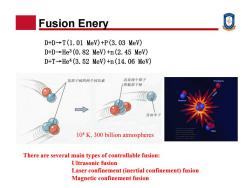
Fusion Enery D+D-T(1.01 MeV)+P(3.03 MeV) D+D-He3(0.82 MeV)+n(2.45 MeV) D+T-He4(3.52 MeV)+n(14.06 MeV) 氢原子核的两个同位素 具有两个质子 的氨原子核 自由中子 108 K,300 billion atmospheres There are several main types of controllable fusion: Ultrasonic fusion Laser confinement(inertial confinement)fusion Magnetic confinement fusion
Fusion Enery D+D→T(1.01 MeV)+P(3.03 MeV) D+D→He3(0.82 MeV)+n(2.45 MeV) D+T→He4(3.52 MeV)+n(14.06 MeV) There are several main types of controllable fusion: Ultrasonic fusion Laser confinement (inertial confinement) fusion Magnetic confinement fusion 108 K, 300 billion atmospheres
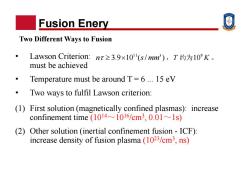
Fusion Enery Two Different Ways to Fusion Lawson Criterion:nx≥3.9xl0'(s/mm),T约为l0K。 must be achieved Temperature must be around T=6...15 eV Two ways to fulfil Lawson criterion: (1)First solution (magnetically confined plasmas):increase confinement time (1014~1016/cm3,0.01~1s) (2)Other solution (inertial confinement fusion -ICF): increase density of fusion plasma(1023/cm3,ns)
Fusion Enery • Lawson Criterion: must be achieved • Temperature must be around T = 6 ... 15 eV • Two ways to fulfil Lawson criterion: (1) First solution (magnetically confined plasmas): increase confinement time (1014~1016/cm3 , 0.01~1s) (2) Other solution (inertial confinement fusion - ICF): increase density of fusion plasma (1023/cm3 , ns) Two Different Ways to Fusion 要实现受控核聚变,必须满足两个基本条件,一是必须将燃料加热到很高的热核反应 温度;二是,必须在足够时间长时间内将高温高密度等离子体约束在一起。Lawson 判据限 定了实现核聚变的具体条件,即受约束的等离子体必须达到一定的密度 n 、温度 T 及约束 时间 。对氘氚反应, 3.9 10 ( / ) 11 3 n s mm ,T 约为 K 8 10

Fusion Enery Inertial Confinement Fusion Concept Radiation ◆Blowoff Inward transported thermal energy Laser beams or Fuel is compressed During the final Thermonuclear laser-produced by the rocketlike part of the capsule burn spreads x rays rapidly heat blowoff of the hot implosion,the fuel rapidly through the surface of the surface material. core reaches the compressed fusion target, 20 times the fuel,yielding forming a density of lead many times the surrounding and ignites at input energy. plasma envelope. 100,000.000°C. Create high pressure high temperature ignition plasma
Fusion Enery Inertial Confinement Fusion Concept Create plasma high pressure high temperature ignition
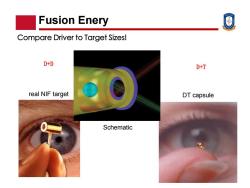
Fusion Enery Compare Driver to Target Sizes! D+D D+T real NIF target DT capsule Schematic
Fusion Enery real NIF target Schematic DT capsule Compare Driver to Target Sizes! D+D D+T
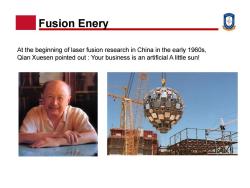
Fusion Enery At the beginning of laser fusion research in China in the early 1960s, Qian Xuesen pointed out:Your business is an artificial A little sun!
Fusion Enery At the beginning of laser fusion research in China in the early 1960s, Qian Xuesen pointed out : Your business is an artificial A little sun!
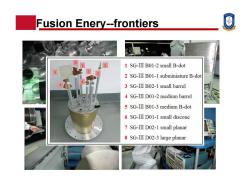
Fusion Enery--frontiers 8 1 1 SG-III B01-2 small B-dot 5 72 2 SG-III B01-1 subminiature B-dot 3 SG-III B02-1 small barrel 4 SG-III D01-2 medium barrel 5 SG-III B01-3 medium B-dot 6 SG-III D01-1 small discone 7 SG-III D02-1 small planar 8 SG-III D02-3 large planar
Fusion Enery--frontiers

Fusion Enery--frontiers Hot electrons can be generated in the laser focal spot and escape from the surface,which may carry i important information to understand some specific physical processes regarding laser and target interactions in ICF. e>eΦ Target ax electrostatic spot radius Φ→0 OA aA R,electron cloud radius 8t 000 E Rfocal spot radius Φ=const E i-×=-器 E Target surface
Fusion Enery--frontiers Hot electrons can be generated in the laser focal spot and escape from the surface, which may carry important information to understand some specific physical processes regarding laser and target interactions in ICF
按次数下载不扣除下载券;
注册用户24小时内重复下载只扣除一次;
顺序:VIP每日次数-->可用次数-->下载券;
- 电子科技大学:《物理与化学电源基础 Fundamental of Physical and Chemical Power Sources》课程教学资源(课件讲稿,第一部分)Section I Background and Fuel Cell(陈俊松).pdf
- 电子科技大学:《物理与化学电源基础 Fundamental of Physical and Chemical Power Sources》课程教学资源(课件讲稿,第二部分)Lecture 07 Anode material for LIBs(Lithium).pdf
- 电子科技大学:《物理与化学电源基础 Fundamental of Physical and Chemical Power Sources》课程教学资源(课件讲稿,第二部分)Lecture 06 Anode material for LIBs(Graphite).pdf
- 电子科技大学:《物理与化学电源基础 Fundamental of Physical and Chemical Power Sources》课程教学资源(课件讲稿,第二部分)Lecture 05 Cathode material for LIBs(Li-Mn-O and NCM).pdf
- 电子科技大学:《物理与化学电源基础 Fundamental of Physical and Chemical Power Sources》课程教学资源(课件讲稿,第二部分)Lecture 04 Cathode material for LIBs(LiFePO4).pdf
- 电子科技大学:《物理与化学电源基础 Fundamental of Physical and Chemical Power Sources》课程教学资源(课件讲稿,第二部分)Lecture 03 Lithium-ion Batteries(LiCoO).pdf
- 电子科技大学:《物理与化学电源基础 Fundamental of Physical and Chemical Power Sources》课程教学资源(课件讲稿,第二部分)Lecture 02 Introduction of Lithium Batteries.pdf
- 电子科技大学:《物理与化学电源基础 Fundamental of Physical and Chemical Power Sources》课程教学资源(课件讲稿,第二部分)Lecture 01 Background of Batteries(陈俊松).pdf
- “十四五”可再生能源发展规划(发布稿).pdf
- 《电力系统运行与控制 Power System Operation and Control》课程参考书籍文献:《Operation and Control in Power Systems》PDF电子书(Prof. P. S. R. MURTY).pdf
- 电子科技大学:《电力系统运行与控制 Power System Operation and Control》课程教学资源(课件讲稿)Lecture 10 Power System Security.pdf
- 电子科技大学:《电力系统运行与控制 Power System Operation and Control》课程教学资源(课件讲稿)Lecture 09 Power System Optimal Power Flow.pdf
- 电子科技大学:《电力系统运行与控制 Power System Operation and Control》课程教学资源(课件讲稿)Lecture 08 power system state estimation.pdf
- 电子科技大学:《电力系统运行与控制 Power System Operation and Control》课程教学资源(课件讲稿)Lecture 07 Power System Wide-area Measurement and Control.pdf
- 电子科技大学:《电力系统运行与控制 Power System Operation and Control》课程教学资源(课件讲稿)Lecture 06 Power System Reactive Power and Voltage Control.pdf
- 电子科技大学:《电力系统运行与控制 Power System Operation and Control》课程教学资源(课件讲稿)Lecture 05 Power Generation Control and Frequency Regulation.pdf
- 电子科技大学:《电力系统运行与控制 Power System Operation and Control》课程教学资源(课件讲稿)Lecture 04 Unit Commitment in Power System.pdf
- 电子科技大学:《电力系统运行与控制 Power System Operation and Control》课程教学资源(课件讲稿)Lecture 03 Power System Economic Dispatch.pdf
- 电子科技大学:《电力系统运行与控制 Power System Operation and Control》课程教学资源(课件讲稿)Lecture 02 Introduction.pdf
- 电子科技大学:《电力系统运行与控制 Power System Operation and Control》课程教学资源(课件讲稿)Lecture 01 Introduction of the course(黄琦).pdf
- 电子科技大学:《物理与化学电源基础 Fundamental of Physical and Chemical Power Sources》课程教学资源(课件讲稿,第一部分)Section III Fundamentals of Solar Cell.pdf
- 电子科技大学:《物理与化学电源基础 Fundamental of Physical and Chemical Power Sources》课程教学资源(课件讲稿,第一部分)Section IV THERMODYNAMICS.pdf
- 电子科技大学:《物理与化学电源基础 Fundamental of Physical and Chemical Power Sources》课程教学资源(课件讲稿,第二部分)Lecture 10 Anode material for LIB(TiO2).pdf
- 电子科技大学:《物理与化学电源基础 Fundamental of Physical and Chemical Power Sources》课程教学资源(课件讲稿,第二部分)Lecture 11 Safety of Li-ion Batteries.pdf
- 电子科技大学:《物理与化学电源基础 Fundamental of Physical and Chemical Power Sources》课程教学资源(课件讲稿,第二部分)Lecture 12 Solid-state Electrolyte in Li-ion Batteries(SSE of LIB).pdf
- 电子科技大学:《物理与化学电源基础 Fundamental of Physical and Chemical Power Sources》课程教学资源(课件讲稿,第二部分)Lecture 08 Anode Material for LIBs(Silicon).pdf
- 电子科技大学:《物理与化学电源基础 Fundamental of Physical and Chemical Power Sources》课程教学资源(课件讲稿,第二部分)Lecture 09 Anode material for LIBs(Tin).pdf
- 《电力系统自动化》:利用储能系统提升电网电能质量研究综述.pdf
- 《电力电子技术 Power Electronics》:电能质量指标及其算法的研究.pdf
- 深圳市标准化指导性技术文件:分布式光伏发电系统并网接入技术规范(SZDB/Z 227 - 2017)Technical specification for distributed photovoltaic generation system Grid-connected.pdf
- 智能电网:改善低压农网电压质量的分布式光伏——储能系统优化配置方法.pdf
- 国投甘肃小三峡发电有限公司:浅析水电厂AVC控制策略.pdf
- 中国电机工程学会:核能发电专业发展报告(PPT宣讲稿,2019年11月).pdf
- 山西能源学院:《传热学》课程教学资源(电子教案)第一章 绪论 1.1 传热学的研究内容及其在科学技术和工程中的应用 1.2 热能传递的三种基本方式.pdf
- 山西能源学院:《传热学》课程教学资源(电子教案)第二章 稳态热传导 2.1 导热基本定律-傅里叶定律.pdf
- 山西能源学院:《传热学》课程教学资源(电子教案)第二讲 第一章 绪论 1.3 传热过程和传热系数 1.4 传热学的发展简史和研究方法.pdf
- 山西能源学院:《传热学》课程教学资源(电子教案)第二章 稳态热传导 2.2 导热问题的数学描写 2.3 典型一维导热问题的分析解-通过平壁的导热.pdf
- 山西能源学院:《传热学》课程教学资源(电子教案)第二章 稳态热传导 2.3 典型一维导热问题的分析解-通过圆筒壁的导热 2.4 通过肋片的导热.pdf
- 山西能源学院:《传热学》课程教学资源(电子教案)第三章 非稳态热传导 3.1 非稳态导热的基本概念.pdf
- 山西能源学院:《传热学》课程教学资源(电子教案)第三章 非稳态热传导 3.2 零维问题的分析法-集中参数法.pdf
